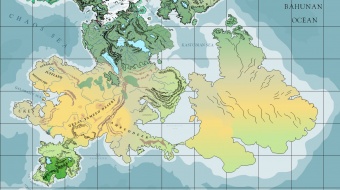Difference between revisions of "Two Bahunas"
Trismegistus (talk | contribs) (created) |
Trismegistus (talk | contribs) m |
||
| Line 3: | Line 3: | ||
In the [[West]], the Two Bahunas have been seen as the same cultural region. The Two Bahunas are in fact considered by [[magdeologer]]s to be parts of the same continent. There are thousands of human and [[humanlike]] cultures in the Two Bahunas which comprise a range of climates from the darkest tropical jungles through arid deserts to the temperate rain forest of [[New Pytharnia]]. The westernmost land mass is called simply [[Bahuna]] or West Bahuna. The easternmost is called [[Za-Bahuna]]. Etymologers are uncertain about the meaning of Za and speculate that it means 'east' or 'sunrise.' The name 'Bahuna' comes into [[west]]ern languages by means of the [[Zephasian Language]]. The greatest river in the Two Bahunas is the [[Inka River]] which passes through the [[Great Yameed Desert]]. The largest empire in the Two Bahunas is the [[Ojo Empire]] which is an important trade destination for merchants. | In the [[West]], the Two Bahunas have been seen as the same cultural region. The Two Bahunas are in fact considered by [[magdeologer]]s to be parts of the same continent. There are thousands of human and [[humanlike]] cultures in the Two Bahunas which comprise a range of climates from the darkest tropical jungles through arid deserts to the temperate rain forest of [[New Pytharnia]]. The westernmost land mass is called simply [[Bahuna]] or West Bahuna. The easternmost is called [[Za-Bahuna]]. Etymologers are uncertain about the meaning of Za and speculate that it means 'east' or 'sunrise.' The name 'Bahuna' comes into [[west]]ern languages by means of the [[Zephasian Language]]. The greatest river in the Two Bahunas is the [[Inka River]] which passes through the [[Great Yameed Desert]]. The largest empire in the Two Bahunas is the [[Ojo Empire]] which is an important trade destination for merchants. | ||
| − | Most of the cultures of the Two Bahunas have had little exposure to civilizations in the [[West]] and explorers bring back varying, sometimes conflicting accounts, which attest to the great cultural diversity. In addition to a myriad of human tribes, the continent is home to numerous humanlike tribes, including [[lizardfolk]], [[quirth]], [[ithrabbi]], [[dracknaughts]], [[gargot]]s, [[ungargot]]s, [[tekmyri]], giants, [[Arwine]] (Leontaurs), and centaurs. | + | Most of the cultures of the Two Bahunas have had little exposure to civilizations in the [[West]] and explorers bring back varying, sometimes conflicting accounts, which attest to the great cultural diversity. In addition to a myriad of human tribes, the continent is home to numerous humanlike tribes, including [[lizardfolk]], [[hyrseka]], [[axmandel]], [[quirth]], [[ithrabbi]], [[dracknaughts]], [[gargot]]s, [[ungargot]]s, [[tekmyri]], giants, [[Arwine]] (Leontaurs), and centaurs. |
=See Also= | =See Also= | ||
Revision as of 14:00, 22 June 2014
In the West, the Two Bahunas have been seen as the same cultural region. The Two Bahunas are in fact considered by magdeologers to be parts of the same continent. There are thousands of human and humanlike cultures in the Two Bahunas which comprise a range of climates from the darkest tropical jungles through arid deserts to the temperate rain forest of New Pytharnia. The westernmost land mass is called simply Bahuna or West Bahuna. The easternmost is called Za-Bahuna. Etymologers are uncertain about the meaning of Za and speculate that it means 'east' or 'sunrise.' The name 'Bahuna' comes into western languages by means of the Zephasian Language. The greatest river in the Two Bahunas is the Inka River which passes through the Great Yameed Desert. The largest empire in the Two Bahunas is the Ojo Empire which is an important trade destination for merchants.
Most of the cultures of the Two Bahunas have had little exposure to civilizations in the West and explorers bring back varying, sometimes conflicting accounts, which attest to the great cultural diversity. In addition to a myriad of human tribes, the continent is home to numerous humanlike tribes, including lizardfolk, hyrseka, axmandel, quirth, ithrabbi, dracknaughts, gargots, ungargots, tekmyri, giants, Arwine (Leontaurs), and centaurs.
See Also
| This article is a stub. It requires further development by the creator. |
